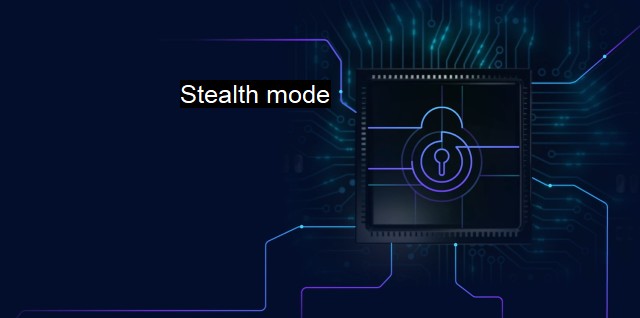What is Stealth mode?
Unleashing The Power of Stealth Mode: A Comprehensive Guide To Cybersecurity and Antivirus
The term "Stealth Mode" is often made reference to. this refers to a mode of operation for software or hardware which minimizes its trackability or detectability by making it invisible to others. In broader terms, the concept simply implies running a device or system without notifying others of its presence. This is critical as it can hide a system’s presence from cybercriminals and protect it from potential attacks.The importance of "Stealth Mode" is emphasized when the protection level given by firewall software comes into the picture. Firewall software typically possesses its own Stealth Mode designed to perfectly cloak a system's ports. Ports are doorways through which internet traffic comes in and goes out. By scanning these, cyber criminals can access unsecured systems and exploit their vulnerabilities. Stealth Mode makes these ports invisible to any unwanted snooping or attempted malicious discovery. It basically convinces those seeking system's information that it does not exist, helping in fending off a crucial step and primitive tactics used by cyberattackers threatening your cybersecurity.
Stealth Mode might also refer to the invisible processes an antivirus uses to detect and swat malicious software. The main vision behind a stealthy antivirus operation aims at leading malware or cyberattack into believing that everything is running normally, whereas in reality, they are being combatted and ejected out of the system. For potential attackers, this means if they do manage to infiltrate the system, they are deceived into thinking their malicious acts are succeeding. In contrast, the stealth antivirus will be working quietly to eradicate or isolate the threat, all without alerting the malware to its activities.
There are some considerations to be made regarding Stealth Mode. These essentially revolve around the fact that resourceful hackers can still find ways to invade what they cannot see. While it does protect against amateur hackers and shelter from many common attacks, experienced hackers may be able to 'guess' the presence of thee machines even if they can’t 'see' them. Cybersecurity is a constant arms race in which attackers and defenders continuously devise ways to outsmart each other.
Stealth mode operations often require quite intensive consumption of computational resources, which, although ensuring improved security, can possibly compromise the performance of other system activities. This signifies the strategic balance that system administrators need to strike between robust security and optimum performance.
Also, remember that Stealth Mode cannot act independently as a cybersecurity solution. It is merely one partial layer of defense that can deter an unsophisticated user scanning for systems to send spam to or a hacker scanning ports looking for weak ones. It is essential to supplement stealth mode with additional, robust cybersecurity strategies and tools. This can include intrusion detection systems, secure protocols, encryption, regular software updates, strong passwords, and multi-factor authentication.
The “Stealth Mode” is an important element of cybersecurity and antivirus strategies, designed to invisibly and quietly defend your systems. Though it does not offer an absolute defense against threats and requires careful consideration of potential performance impacts, it is a crucial portion of a layered defense strategy that augments the resilience of a system towards a variety of cyber threats. The knowledge of stealth mode and implementing it define the initial step toward securing systems, and its importance should not be underestimated. Stealth mode alone would not assure full security it certainly constructs an effective step on the ladder towards achieving an overall safer cybersecurity environment.

Stealth mode FAQs
What is stealth mode in cybersecurity?
Stealth mode is a feature in cybersecurity that allows an antivirus or firewall to operate in a way that remains invisible or undetectable to attackers. The purpose is to prevent attackers from detecting and exploiting vulnerabilities in the system.How does stealth mode work in antivirus software?
Stealth mode in antivirus software involves operating silently in the background without generating any alerts or notifications that an attacker could detect. It can also involve randomizing port numbers, IP addresses, and other characteristics to make it harder for attackers to find and target vulnerable systems.Why is stealth mode important for cybersecurity?
Stealth mode is important for cybersecurity because it makes it harder for attackers to detect and exploit vulnerabilities in a system. By hiding from attackers, antivirus software can protect systems more effectively and minimize the chances of successful cyber attacks.Are there any drawbacks to using stealth mode in antivirus software?
One potential drawback of using stealth mode in antivirus software is that it can make it harder to diagnose and troubleshoot system issues. Additionally, if the software is too stealthy, it could potentially interfere with legitimate applications or processes. It's important to carefully balance the benefits and risks of using stealth mode in any cybersecurity solution.| | A | | | B | | | C | | | D | | | E | | | F | | | G | | | H | | | I | | | J | | | K | | | L | | | M | |
| | N | | | O | | | P | | | Q | | | R | | | S | | | T | | | U | | | V | | | W | | | X | | | Y | | | Z | |
| | 1 | | | 2 | | | 3 | | | 4 | | | 7 | | | 8 | | |||||||